MAKING VARIATIONS TO MEET CHANGING COMBAT SITUATIONS
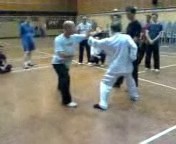
Making Variations to Meet Changing Combat Situations
Having understood why kungfu patterns are used in fighting instead of bouncing about and hitting at random, and why certain patterns executed in certain ways are preferred to other patterns in other ways, we can devise combat sequences to meet these needs. Video clips in earlier series show some of these lessons participants to the Special Shaolin Kungfu Course of September 2005 underwent.
What should we do if an opponent does not fight the way we want him to? Would our combat sequences still be useful if our opponents do not use the techniques or fight in the order we have planned in our combat sequences? In real fighting, opponents don't fight the way we want them to — unless we have attained a very high level in the use of strategies where we can maneuver them to do so often without their knowing.
Even before you have attained such high levels, the combat sequences are still very useful, but we have to make adjustment. The adjustment can be at a technical level or at a sequential level.
At a technical level, suppose according to the sequence you are to execute a “Double Bows Tame Tiger” to counter the opponent's strike, but he attacks with a side kick instead of a thrust punch. Hence you make an adjustment at this point. Instead of shifting your body backward for a “Double Bows”, you retreat you front leg and counter with “Lohan Strikes Drum”, then immediately you move forward with a “Double Bows” (even when he is not attacking with a thrust punch) and continue with your planned sequence.
At a sequential level, you respond with “Lohan Strike Drum”, then immediately continue with another sequence, where “Lohan Strike Drum” may be at the beginning or the middle of the new sequence, or it may not even be in the new sequence. In our sparring methodology, the technical adjustment corresponds to an “addition”, whereas the sequential adjustment corresponds to an “external change” or an “internal change”.
These terms and methods are for understanding and convenience of training. Once you are able to perform them, you need not worry about the steps or terms, you just respond spontaneously. Moreover, the classification here into technical and sequential adjustments is meant for convenience too. Once you are familiar with them, they overlap with each other.
The video clips in this series give an example of this developmental stage of composing combat sequences from specialized sets involving a process called “variations”. Suppose Simon and Mark call this sequence, Five-Animal Sequence 1. If the opponent responds with a surprised snap kick at the groin as shown by Sifu Wong, as soon as Simon responds with a “mirror hand”, Simon would then continues with Variation 1a instead of continuing with the usual Sequence 1. Or, suppose the opponent uses “Single Knife” to intercept Simon's strike, Simon would continue with Variation 1b, and so on.
Understanding Philosophy of Combat Sequences
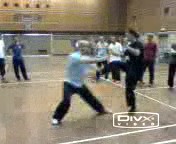
Simon and Mark go over a combat sequence they have earlier composed, and explain the philosophy behind the composition.
Be Prepared for a Deadly Counter
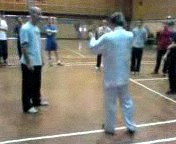
Sifu Wong reminds the participants that they have to be careful of an important point when using a sideway Bow-Arrow Stance. He then demonstrates what a skillful exponent might do, against which we must have a ready response. The significant factor here is not whether the opponent knows this surprise move, but we must be ready for it regardless of whether he knows, as it gives him a deadly advantage.
Subduing a Dragon
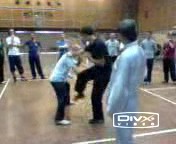
When we chop at an opponent's leg as he kicks, we must be careful that he may attack our exposed head. If he does so, we can respond with “Subduing a Dragon” which can dislocate the opponent's elbow.
Variation from Standard Sequence
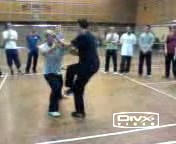
As Simon responds with a chop at Mark's neck, instead of moving back as in the standard sequence, a variation is to move sideway.
Intercepting with Single Knife

Instead of moving back to “False Leg Hand Sweep” as in the standard sequence, a variation Mark may use is to intercept Simon's palm chop with “Attend Conference with Single Knife”, dislocating or fracturing the opponent's elbow.
Counter with Organ-Seeking Kick
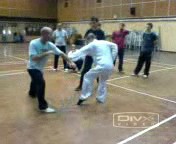
Sifu Wong explains to Mark the economy of movement in a hand sweep. Then as Simon attacks with a horizontal palm chop, Mark circulates his hand to ward off the attack and counters with an organ-seeking kick.
LINKS
Lessons from the Special Shaolin Kungfu Course of September 2005
- Part 1 - Initiating and Responding to Attacks
- Part 2 - Secrets in Counters against Boxer's Attacks
- Part 3 - Process of Composing a Kungfu Set
- Part 4 - Combat Sequences from Specialized Sets
- Part 5 - Refining Combat Sequences of Specialized Sets
- Part 6 - Making Variations to Meet Changing Combat Situations
- Part 7 - Bringing out the Beauty of Shaolin Kungfu in Combat
- Part 8 - From Pattern-Sets to Sequence-Sets
- Part 9 — Sparring at the Haphazard, Technique and Sequence Levels
- Part 10 — Improving Techniques and Flow in Free Sparring
- Part 11 — Free Sparring using Kungfu Skills and Techniques
- Part 12 — The Flowing Water Staff and its Application
